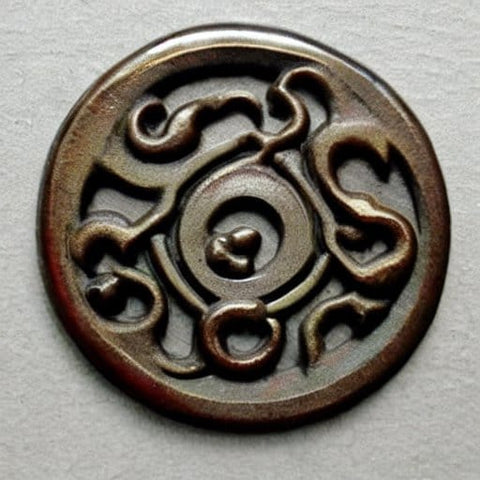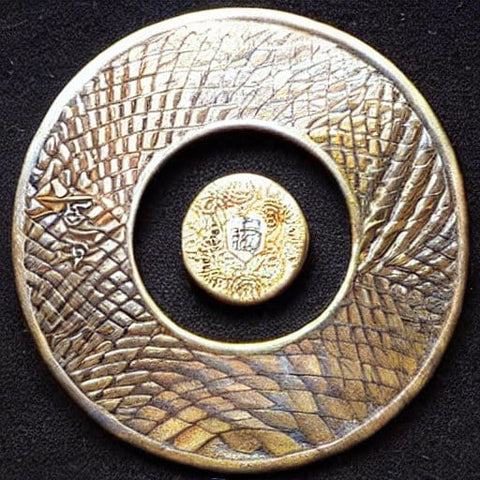
Tsuba (Sword Guards): Protecting and Adorning the Blade
Share
Tsuba, also known as sword guards, play a significant role in the world of Japanese swords. These ornate and functional components not only provide protection for the hand but also serve as a canvas for artistic expression. In this article, we explore the rich history, craftsmanship, and cultural significance of Tsuba (sword guards), as well as their continued relevance in modern times.
Introduction to Tsuba (sword guards)
Tsuba, originating in Japan during the 8th century, are circular or oval-shaped guards that are mounted on the hilt of a Japanese sword, such as a katana or a wakizashi. They act as a protective barrier between the hand of the wielder and the blade, preventing accidental slippage and offering additional defense in combat.
Historical significance of Tsuba
During feudal Japan, the art of swordsmanship reached its peak, and Tsuba became essential accessories for samurai warriors. The design and quality of a Tsuba served as a status symbol, representing the wealth and social standing of its owner. Tsuba were often customized and passed down through generations, becoming cherished family heirlooms.

Evolution of Tsuba designs
Over the centuries, Tsuba designs evolved in response to various influences, including changes in combat techniques, artistic trends, and cultural shifts. Early Tsuba designs were simple and utilitarian, featuring minimal ornamentation. However, as peace prevailed during the Edo period, Tsuba designs became more elaborate and intricate, incorporating a wide range of artistic motifs.
Materials used in Tsuba production
Tsuba can be crafted from various materials, including iron, copper, brass, gold, silver, and alloys. Iron Tsuba are known for their durability, while precious metal Tsuba showcase the exquisite skill of metalworkers. Some Tsuba also incorporate materials like bamboo, wood, or lacquer for added texture and visual interest.
Symbolism and decorative elements in Tsuba
Tsuba often incorporate symbolic elements and decorative motifs inspired by nature, mythology, historical events, and religious beliefs. Cherry blossoms represent the transient nature of life, dragons symbolize power and strength, and waves signify the ebb and flow of existence. These intricate designs are meticulously engraved or inlaid into the Tsuba, showcasing the craftsmanship and attention to detail.
Tsuba craftsmanship and techniques
Creating a Tsuba requires specialized skills and techniques. Master artisans employ a combination of metalworking techniques such as carving, engraving, inlaying, and patination to bring the design to life. These techniques demand precision and patience, resulting in Tsuba that are not only functional but also exquisite works of art.
Collecting and appreciating Tsuba as art
Tsuba have gained recognition as collectible art pieces. Art enthusiasts and collectors appreciate the craftsmanship, historical significance, and aesthetic appeal of these miniature sculptures. Collectors often seek out Tsuba that showcase unique designs, exceptional craftsmanship, and historical provenance. The value of Tsuba as collectibles can vary significantly based on factors such as rarity, condition, and the reputation of the artist.
Care and maintenance of Tsuba
To preserve the beauty and integrity of Tsuba, proper care and maintenance are essential. Tsuba should be kept in a dry and controlled environment to prevent corrosion or damage. Regular cleaning using non-abrasive materials and techniques is recommended to remove dirt and dust. Additionally, applying a thin layer of protective wax can help prevent oxidation and maintain the Tsuba's luster.
Tsuba in modern sword-making
While Tsuba continue to be cherished for their historical and artistic value, they also have a place in modern sword-making. Contemporary artisans and swordsmiths create Tsuba using traditional techniques, infusing them with their unique artistic vision. These modern Tsuba often combine traditional motifs with innovative materials and designs, bridging the gap between the past and the present.
Tsuba as a reflection of cultural identity

Tsuba (sword guards) not only serve functional and decorative purposes but also reflect the cultural identity of the people who created and used them. The choice of motifs, materials, and craftsmanship techniques incorporated into Tsuba can provide insights into the cultural and historical context of a particular period. They are a testament to the creativity, skills, and values of the artisans who crafted them.
Famous Tsuba artisans and their contributions
Throughout history, numerous skilled artisans have left their mark on the world of Tsuba. Masters such as Myochin, Shoami, Goto, and Akasaka were renowned for their exceptional craftsmanship and innovative designs. Their contributions to Tsuba artistry have shaped the development and evolution of this unique form of expression.
Tsuba in popular culture and media
The allure of Tsuba (sword guards) has transcended its historical significance and seeped into popular culture and media. Tsuba often make appearances in movies, television shows, and video games, adding a touch of authenticity and visual appeal to the depiction of Japanese swords and samurai culture. Their inclusion in popular media further enhances the fascination and appreciation for these intricate works of art.
The market for Tsuba and its value
Tsuba (sword guards) have become sought-after collectibles in the art market. The value of a Tsuba can vary greatly depending on factors such as its historical importance, rarity, craftsmanship, and condition. Auctions, specialized galleries, and online platforms cater to collectors and enthusiasts, providing opportunities to acquire and appreciate these unique pieces of art.
Tsuka, Tsuba and Saya
Tsuka, Tsuba, and Saya are distinct components of a Japanese sword.
The Tsuka refers to the hilt or handle of the sword, typically made from wood and wrapped with a fabric called Tsukaito. It provides a comfortable grip and is often adorned with menuki (decorative metal ornaments).
The Tsuba, as discussed earlier, is the sword guard. It is a circular or oval-shaped piece made of metal and mounted on the Tsuka. Its primary function is to protect the hand and prevent it from sliding onto the blade during combat. Tsuba also serves as an artistic canvas, showcasing intricate designs and symbolic motifs.
The Saya refers to the scabbard or sheath of the sword. It is usually made of wood, coated with lacquer, and provides a protective covering for the blade when it is not in use. The Saya can be decorated with various materials such as mother-of-pearl inlays or decorative cords (Sageo) for added aesthetic appeal.
In summary, the Tsuka is the handle, the Tsuba is the guard, and the Saya is the sheath of a Japanese sword. Each component serves a specific purpose and contributes to the functionality and beauty of the overall sword design.
Conclusion
Tsuba (sword guards) hold a significant place in the world of Japanese swords, combining functionality with artistic expression. Throughout history, they have evolved in design, reflecting changes in combat techniques, artistic trends, and cultural influences. Today, Tsuba continue to captivate collectors and enthusiasts as valuable artifacts that preserve the rich cultural heritage of Japan. Whether as historical treasures or contemporary works of art, Tsuba (sword guards) stand as testament to the craftsmanship, creativity, and cultural identity of the artisans who crafted them.
FAQs (Frequently Asked Questions)
-
Can Tsuba be removed from a Japanese sword? Yes, Tsuba can be detached from a Japanese sword by carefully unscrewing the hilt's retaining nut.
-
Are all Tsuba handmade? While traditionally Tsuba were handmade by skilled artisans, some modern replicas or mass-produced Tsuba may be manufactured using machinery.
-
How can I determine the authenticity of a Tsuba? Authenticity can be determined through a combination of factors such as historical documentation, expert appraisal, and knowledge of recognized Tsuba styles and signatures.
-
Are Tsuba only found on Japanese swords? Tsuba (sword guards) are primarily associated with Japanese swords, but their influence has spread to other weapons and cultural artifacts. Tsuba-like guards can be found on various Japanese weapons like naginatas and tanto knives. Additionally, Tsuba-inspired designs have been incorporated into decorative items such as jewelry, belt buckles, and even fashion accessories.
-
Can I commission a custom-made Tsuba? Yes, it is possible to commission a custom-made Tsuba from skilled artisans or specialized workshops.

